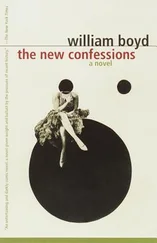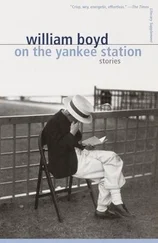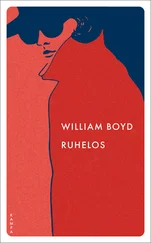Staring at square yards of these paintings two comparisons came to mind as I tried to register and evaluate their effect. First of all they seemed to possess the properties of tapestries, rather than paintings. The absence of depth of field is the clearest similarity, and the flatness of the visual plane and the diminished or non-existent perspective are very tapestry-like. So too is what might be termed the picture’s dogged egalitarianism. The very top right hand corner of Christ Delivered to the People —a branch of a tree, a wall, a neutral section of street — is rendered with precisely the same care and attention, sharpness of focus and concentration on detail as is Christ’s face! This is the democratic deadening effect of tapestry, one stitch enjoying exactly the same status as another, but is not normally a consequence of painting, except in one genre of it — which brings me to the second comparison — namely hyperreal-ism. One is hugely impressed, full of admiration, before these large Spencer pictures, almost stunned by these vast testimonials to his prodigious diligence and tirelessness, in much the same way as one is amazed how this or that airbrush-wielding hyperrealist has captured every gleam and warped reflection, every twinkle and dent, in the chrome innards of a Harley Davidson. Look at the Waking Up panel of the Port Glasgow Resurrection . Each leaf is there, every blade of grass, every petal on the primroses (yet the babies have the individuality of lumps of dough, strangely). But this sedulous industry — like hyperrealism — is in the end a facile talent, indicative more of a certain hyper-patient cast of mind than of genuine artistry or genius. And nowhere is this better illustrated than in the huge unfinished canvas (twenty feet by six feet) The Apotheosis of Hilda .
Perhaps “barely started” would be a more apt description than “unfinished,” as only the top left hand corner is actually painted, approximately one twelfth of the canvas. The rest is ready for painting, and in a way that is highly revealing of Spencer’s methods. In fact the expanse of white canvas is more like a sheet from a giant sketch pad: most of the rest of the composition has been drawn on the surface in pencil, but drawn in the most elaborate detail — even the fishnet mesh of Hilda’s gloves has been cross-hatched in. And what has actually been completed — and this is not meant to sound flippant — forcibly reminds one of an abandoned “paint-by-numbers” exercise. Looking at the painted twelfth of the picture, it is immediately obvious that the completed work would have been the Apotheosis of Detail also. Spencer has painted virtually every pebble on the ground, every brick in a wall. Here and there the white circle of an untreated face waits for later attention. The effect of so much effort is disorientating: clearly on paintings of this scale this kind of method, or something similar, has to be employed simply to get proportions right and composition exact, but it has to be said that there is something soullessly mechanical about this laboured depiction of minutiae: leaf by leaf, pattern by pattern, stitch by stitch it goes, a monstrous pseudo-Gobelin, the triumph of pertinacity over afflatus.
What is in the end so exasperating (and I think that one word sums up the complexity of response this exhibition stimulates in me) is that counter-examples abound, and not just in the rapt carnality of the Patricia Chapel. There is a portrait of Hilda Spencer— Seated Nude —which is equally fine. As with the Patrica Preece portraits, it exhibits a sensitivity to the potential and resources of oil paint far superior to anything in the large allegories or religious paintings, not just in the freedom with which the paint is applied, or reproduction of subtle skin tones, but also an awareness of how impasto and wash, highlight and shadow, of overt brushmark set beside absolute smoothness can simulate the contours of the body and properties of skin with spectacular success. The effect of the bulge of muscle over bone on Hilda’s right shoulder is achieved by thick strokes of pale coral set just below the smooth cream highlights where the skin is stretched over the deltoid. The axillary folds above her breast are painted slate grey, almost scumbled, with the white weave of the canvas allowed to show through as highlights. Over and above this technical mastery the wholly uncompromising honesty of the painter’s eye is again very powerful. It is the antithesis of idealization, but derives its power precisely from that ruthlessness. The flesh tones of the face are markedly darker than the hues of the torso, suiting the slight frown on Hilda’s brow and the odd, troubled, askance nature of her gaze. One needs no specialized biographical information to recognize this as a great picture; all its ingredients fuse superbly. As they do in the portraits of the Patricia Chapel and as they do, for example, in the three marvellous self-portraits of 1914, 1936 and 1959.
By emphasizing the achievements of these portraits over the religious and allegorical paintings I do not wish to denigrate work that we might normally and unreflectingly regard as quintessential Stanley Spencer. But the division exists, and the artistry and spirit that infuse the former seem only marginally present in the latter. Furthermore the allegories and religious paintings are heavily encoded, replete with possible interpretations. Some of them have a more public dimension — great religious themes — others remain irreducibly private. From this stem further ambiguities and problems of response. Standing before a picture that is manifestly the product of a personality at once so eccentric and idiosyncratic can be unsatisfying: one’s own emotional and intellectual comprehension seems inadequate or nugatory. What is one to make of The Chest of Drawers , for example? A large woman looms over a small man rummaging in the bottom drawer of a chest. Superficially it seems to me badly painted — textureless, hurried, faux naïf —and as for its content I suppose it might pass muster as a private joke or whimsical jeu d’esprit . However, set in the full context of Spencer’s life, buttressed and explicated by what we know of his personal history and his private needs and desires, from information gleaned from his letters and journals, the painting takes on a different significance and is judged by altogether different standards. But this is to make the picture an adjunct to autobiography — as a work of art it still seems to me deficient. By this I don’t want to imply that great or good art must necessarily have an accessible public dimension — I am not insisting that the cryptic and the obscure exclude themselves from evaluation by their very nature. On the contrary, the truly private import of, say, the Leg of Mutton Nude will probably remain for ever buried. But the picture exists for us in a way that, for example, The Lovers or A Village in Heaven don’t. If we are denied — or are uncertain of — the significance of the images in a picture then the only way we can respond to it is either through some purely private correspondence — a fortuitous subjective recognition — or else by traditional methods of evaluation. This is the case with many of Spencer’s pictures, and they suffer thereby. The same disadvantage besets the religious paintings. Suffused as they are with Spencer’s highly individual sacramental vision, the odds on chiming with it naturally and spontaneously are small. Hence the almost inevitable accusations of whimsy (the British disease) or facetiousness. No such occlusion conditions our response to the portraits.
Not everyone would agree with Frank Auerbach’s conviction that the only lasting and valid test of an artist’s worth is how he or she treats the posed human figure. Mind you, they might not agree because it is such an exacting yardstick, before which many a lesser or vainglorious talent has its inadequacies brutally exposed. However, in a slightly wider context the assertion does have a real bearing on Spencer and his corpus of work. The great problem for artists of narrative, allegorical, ideological or symbolic subjects is that, more often than not, it is the story, the allegory, the politics, or the symbol itself, which fascinate, far more than the medium through which they are rendered. Form, as the cliché has it, is sacrificed to content. Hence the enduring presence of those great eternals in an artist’s repertoire — the posed figure, the nude, the self-portrait, the interior, the still life, the landscape. Because the nature of the subject is so timeless, the balance between form and content remains in equilibrium. And it takes a real, not to say great, artist to raise the subject from the humdrum to the sublime.
Читать дальше












